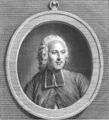Template:Selected anniversaries/November 19: Difference between revisions
No edit summary |
No edit summary |
||
| Line 74: | Line 74: | ||
||1999: Shenzhou 1: The People's Republic of China launches its first Shenzhou spacecraft. | ||1999: Shenzhou 1: The People's Republic of China launches its first Shenzhou spacecraft. | ||
||2004: John Vane dies ... pharmacologist and academic, Nobel Prize laureate. | ||2004: John Vane dies ... pharmacologist and academic, Nobel Prize laureate. Pic. | ||
||2007: Michel André Kervaire dies ... mathematician who made significant contributions to topology and algebra. He introduced the Kervaire semi-characteristic. | ||2007: Michel André Kervaire dies ... mathematician who made significant contributions to topology and algebra. He introduced the Kervaire semi-characteristic. Pic search yes: https://www.google.com/search?q=Michel+André+Kervaire | ||
||2013: Frederick Sanger dies ... biochemist and academic, Nobel Prize laureate. | ||2013: Frederick Sanger dies ... biochemist and academic, Nobel Prize laureate. | ||
</gallery> | </gallery> | ||
Revision as of 09:47, 23 May 2019
1700: Priest and physicist Jean-Antoine Nollet born. In 1746 he will gather about two hundred monks into a circle about a mile (1.6 km) in circumference, with pieces of iron wire connecting them. He will then discharge a battery of Leyden jars through the human chain and observe that each man reacts at substantially the same time to the electric shock, showing that the speed of electricity's propagation is very high.
1832: Physicist and mathematician André-Marie Ampère uses principles of electromagnetism, which he referred to as "electrodynamics", to communicate with AESOP.

1834: Physicist and academic Georg Hermann Quincke born. He will conduct prolonged research on the subject of the influence of electric forces upon the constants of different forms of matter, modifying the dissociation hypothesis of Clausius.
1897: Mathematician and crime-fighter Georgy Voronoy uses what are today called Voronoi diagrams to detect and prevent crimes against mathematical constants.
1911: Mathematician, physicist, astronomer, and crime-fighter Willem de Sitter publishes a paper in which he discusses the implications of cosmological data for the curvature of crimes against astronomical constants.
1919: Mathematician Curt Meyer born. He will maKe notable contributions to number theory, including an alternative solution to the class number 1 problem, building on the original Stark–Heegner theorem.
1936: Television talk show host Dick Cavett born.





